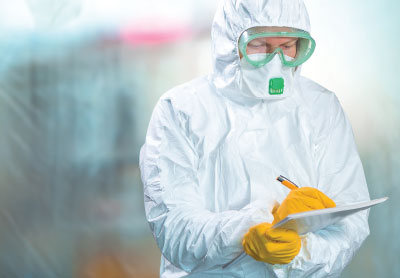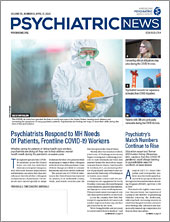The explosive spread of the COVID-19 pandemic across the United States not only has mobilized clinicians in hospital emergency and infectious disease departments and intensive care units, but also has enhanced the role of their colleagues in departments of psychiatry. Psychiatrists have moved quickly to adapt treatment for their own patients while stepping up to support their colleagues at the front lines of the pandemic. Some of those changes are likely to continue beyond the end of the current outbreak.
The initial case of COVID-19 infection in the United States was reported on January 20 in Snohomish County, Wash., and Seattle soon became the first hot spot in the United States.
“Shortly after this situation evolved, [University of Washington Medicine] began creating and confirming protocols to start telemedicine visits into patients’ homes for most of our outpatient psychiatric clinics,” said Jennifer M. Erickson, D.O., an assistant professor of psychiatry and behavioral sciences at the University of Washington in Seattle, in an email.
To minimize contact and save personal protective equipment for use by frontline clinicians, they used hospital room telephones, patients’ smartphones, and laptops to connect with inpatients. When personal contact was required, only one clinician was allowed in the room.
Across the country, New York University’s Langone Medical Center took similar steps in its home city, another place hard hit by the virus.
“We’re being flexible and are ready to convert psych beds to medical,” said Langone’s Marra Ackerman, M.D., a clinical assistant professor of psychiatry and director of the house and student mental health program. “We’re still taking inpatient admissions, but they are more acute.”
To limit exposure, some services like consultation-liaison psychiatry have largely converted to telemedicine but with an on-site psychiatrist to manage emergencies, she said in an interview. Nursing liaisons are assisting with telepsychiatry consults at the bedside.
“We usually have three inpatient attending psychiatrists, but now we have only one on-site with two others working remotely,” said Ackerman in an interview. “And we’re now trying to convert group sessions to video.”
Use of telemedicine has mushroomed everywhere, both out of necessity and thanks to changes in federal rules driven by COVID-19.
“The Substance Abuse and Mental Health Services Administration [SAMHSA] wants to make sure that clinicians can make use of telehealth,” said Elinore McCance-Katz, M.D., assistant secretary for mental health and substance use in the Department of Health and Human Services and head of SAMHSA. SAMHSA is offering training and technical assistance to help mental health professionals during the pandemic.
“Technology is a very important part of addressing this issue,” said McCance-Katz in an interview. “Our Office of Civil Rights will not take action if telehealth modalities that are not in compliance at this time are used during the emergency to make as many possible resources available to individuals who may not be able to get to their doctor or provider but who need to be evaluated or who may need assistance.”
Besides adapting to help patients, clinicians are working to support their colleagues on the COVID-19 wards. Some are creating systems on the fly, while others are building on existing in-house programs.
“The value that psychiatry brings is recognized by everyone in health care,” said APA President Bruce Schwartz, M.D., a professor and deputy chair of psychiatry and behavioral sciences at Montefiore and the Albert Einstein College of Medicine in New York. “During this crisis they need us to continue to care for our patients and especially to work with our medical staff who are under incredible stress.”
The University of Washington team began with an existing independent peer support program in nonpsychiatric departments that used faculty and staff members specially trained in behavioral health, said Mollie Forrester, M.S.W., director of patient and family experience in the department. “In addition, the Department of Psychiatry and Behavioral Sciences started a COVID-19 peer support line offering access to a department faculty psychiatrist, psychologist, social worker, or other clinician.”
“People on the front lines are working long hours, they fear contracting the disease or infecting their families, and they worry about having enough protective equipment and making difficult decisions about patient care,” said Alyssa Rheingold, Ph.D., associate director of the sleep and anxiety program in the Department of Psychiatry at the Medical University South Carolina (MUSC) in Charleston. She put their program together in four days, piggybacking on MUSC’s employee assistance program. “We’re a resource for anyone—doctors, nurses, medical technicians—who are struggling now.”
They reminded their colleagues that they are normal people dealing with abnormal stress. They have posted flyers offering help with contact names, email addresses, and phone numbers. Their suggestions for managing stress include asking individuals to look into their own pasts to recall what helped them through other stressful periods, to keep up healthy practices like good sleep and exercise, and to stay off social media, said Rheingold. “I tell ER residents to do important, purposeful, joyful things when they get time off. Stay in the hammock, play with the dog, or read a book to build your personal resilience.”
NYU Langone already had a strong history of providing mental health services to faculty and staff, said Ackerman. Now, her team is using video and telephones to provide mental health services to employees. In addition to physicians and nurses, her group is working with housekeepers and building maintenance personnel because they are also at risk and crucial to hospital operations. They began virtual support groups for workers across all of NYU Langone’s campuses, staffed by psychiatry department faculty, and have prioritized new referrals for frontline staff.
“Now our goal is to support everyone in whatever ways possible,” she said. “It’s an all-hands-on-deck effort. We have staff who are volunteering to work additional hours to meet the demand.”
Ackerman’s biggest worry is not knowing how long the pandemic will go on. “We’re all in it together, and we’ll get to the other side,” she said.
In some ways, many of the short-term tools to meet the pandemic may result in longer-term changes. Many impediments to care have suddenly disappeared under the weight of the pandemic. Some telemedicine limitations have been eliminated, for instance, perhaps due to the near ubiquity of and familiarity with digital technology. There may be systemic changes, as well.
“I hope this epidemic will eventually foster a critical examination of our health care system and an investment in public health and mental health,” said Schwartz.
Psychiatrists with experience in disaster response have long recognized that the consequences that result may not appear until months or years after a traumatic event.
“That’s what’s keeping me up at night,” said Ackerman. “Our first goal is to get through this crisis, but the long-term effects will be daunting.”
Providing support now may prevent long-term issues once the pandemic subsides, said Forrester. “We will have a peer-to-peer support program in place after this pandemic subsides, so that we can help UWM providers when they begin to reflect on what they have experienced.”
“We must remain appropriately positive, to provide hope and not be too despairing,” said Frederick Stoddard, M.D., a professor of psychiatry at Harvard Medical School and Massachusetts General Hospital and a co-author of Disaster Psychiatry Readiness, Evaluation, and Treatment from APA Publishing.
“Listening to our colleagues’ worries and the nature of their distress is important.” ■

